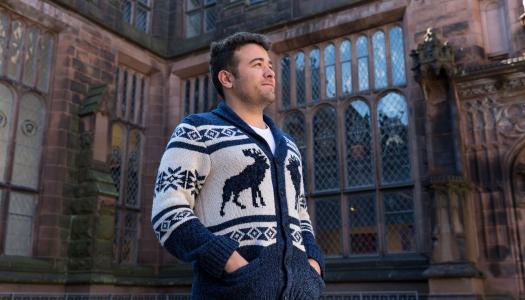Chitra Parikh ’21: Projects for Peace Recipient Takes Neighborly Approach to Promote Health

This summer, Chitra Parikh ’21 will be organizing weekly community dinners for Philadelphians who live in the Kensington neighborhood, with the goal of promoting healthy eating choices and promoting social change.
As a 2019 recipient of a $10,000 Davis Projects for Peace award, Parikh will create and administer a nutrition education curriculum as part of a Health Design Lab food access pilot program. The lab, whose staff are associated with Thomas Jefferson University and its medical college, serves as a creative space to bring people, health care, and community-generated problem solving together outside the walls of a hospital.
Philanthropist Kathryn Wasserman Davis established Projects for Peace in 2007 in honor of her 100th birthday to encourage future leaders toward peace activism in broad terms. All undergraduates at the American colleges and universities which partner in the Davis United World College Scholars Program are eligible to compete for one of 120 grants.
Davis was the widow of Shelby Cullom Davis of the Princeton class of 1930, and mother of Shelby M.C. Davis, of Princeton’s class of 1958. She and her son endowed Princeton’s international center, which is now named in their honor.
Encouraging Healthy Choices
Kensington residents face high rates of unemployment and homelessness. In addition, the Health Design Lab identified the neighborhood as the focal point of Philadelphia’s opioid epidemic. Parikh’s Project for Peace focuses on food as a primary determinant of health. Outdoor weekly community dinners will feature homemade healthy meals, meal preparation demonstrations, and discussions on making good nutritional choices.
“I think that food insecurity and the opioid health crisis are very intertwined and it’s important to think about health in the social context as much as in the medical context when crafting solutions,” said Parikh, whose campus activities include participation in Service Focus — Princeton’s recently launched two-year program to integrate service and learning — and election to the Undergraduate Student Government.
The dinners will provide a time for Parikh and colleague researchers to work with community members on co-designing long-term projects around food access and food insecurity, as well as an opportunity to reshape the narrative around community spaces currently overwhelmed by opioid addiction.
“The idea is that through these dinners the community spaces will be reactivated,” Parikh said.
Design Thinking for Health Care
Parikh plans to incorporate design thinking — an approach to problem solving that purposefully incorporates user perspectives to produce creative solutions — into her project by ensuring numerous points of community feedback throughout the summer. Using this feedback, she will adjust the structure of the community dinners and educational materials.
Health Design Lab’s work attracted the architecture major from Hillsborough, NJ, because it straddles the intersection of design thinking and health care. Parikh has applied design thinking to systemic health problems as part of Princeton’s Tiger Challenge program, in which teams partner with communities in creative problem solving.
As part of the MedComm Tiger Challenge Team in 2018, Parikh studied the communication barriers that occur in an outpatient practice at Robert Wood Johnson University Medical Group, a major academic health center in New Jersey. In 2016, Parikh worked with a local school district to develop innovative approaches to improving adolescent mental health as part of the StressLess Tiger Challenge Team.
“I think there’s something important about the way that this methodology puts the user first,” she said. “Design thinking is super relevant to health care because good patient care is rooted in perspective. At the end of the day patient care is as much about the diseases and biology as the experiences and emotions felt in clinical settings.”
For more information on Projects for Peace, see www.davisprojectsforpeace.org.
Photo by Gwen McNamara, Pace Center for Civic Engagement


